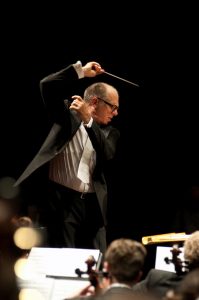Renga Ensemble Presents a Bouquet of Seminal 20th-Century Works to Climax the ‘Hearing the Future’ Festival
Renga, a heady fusion of virtuoso instrumentalists from UC San Diego and the San Diego Symphony, offered a probing coda to the Symphony’s January festival “Hearing the Future” on Saturday (January 26) at the university’s Conrad Prebys Concert Hall.

Steven Schick [photo (c) Tom Peisch]
This “under the microscope” approach was suggested by Arnold Schoenberg’s chamber music adaptation for 14 instruments and two singers of Gustav Mahler’s massive 1909 orchestral song cycle Das Lied von der Erde. Following this example, Renga commissioned Cliff Colnot to make a version of Claude Debussy’s 1913 imposing orchestral work Jeux for 16 players. With Schoenberg’s Fantasy for Violin and Piano, Op. 47, Renga worked in the opposite direction, requiring Asher Tobin Chodos to arrange this duo into a sextet of flutes, harp, contrabass, and two percussionists to accompany the solo violin.
I was astounded by Colnot’s chamber version of Jeux. Debussy’s dissonances were no longer cushioned by massive string sections, so his harmonic language sounded more acerbic, and the percussion players gave a telling edge and insistent definition in this more intimate instrumental assemblage. The work’s magical, rapturous instability—fueled by constant tempo and meter changes—was significantly heightened in this chamber version, allowing a bolder awareness of Debussy’s masterful “mercurial scherzando,” as New York Times music critic Anthony Tommasini so aptly described Jeux in a review of an orchestral performance he heard in 2012.
Aucoin brought the spectacular violinist Keir GoGwilt to “Hearing the Future,” but what he did to energize and illuminate works by John Adams and Aucoin in last week’s chamber concert at the Auditorium at TSRI only hinted at his ability to make Schoenberg’s 12-tone Violin Fantasy almost as exciting and immediate as those syrupy Romantic violin showpieces by Max Bruch. In addition to GoGwilt’s pyrotechnical flair, his bright sonority and rich vibrato as well as his ability to project graceful melodic contours out of the composer’s often jagged motifs proved deliriously insistent. Chodos’ exotic transformation of the piano part, notably by using vibraphone, xylophone and an array of smaller drums, could snare even a casual listener’s attention. If this is what “cerebral, arid serial music” sounds like, sign me up for a whole lot more of it!
In spite of the Schick’s immaculate direction of Schoenberg’s redaction of Mahler’s Das Lied von der Erde, the fine performances he coaxed from his first-rank instrumentalists, and the sophisticated vocal interpretations of both mezzo-soprano Jessica Aszodi and tenor John Russell, I cannot say this adaptation of the great orchestral work brought great revelation. Mahler needed that massive, orchestral gravity to embody Weltschmerz of this dimension, and although this ensemble version rekindled memories the orchestral original, it did not recreate for me its emotional depth.
The bright edge of Russell’s warm tenor voice took some of the foreboding out of the opening movement’s stentorian “Dunkel is das Leben, ist der Tod” refrain, but his crystalline German diction and always supple phrasing communicated both the heart and nuance of this ancient Chinese poetry rendered into German by the poet Hans Bethge. Aszodi’s bold mezzo and her assured declamation were equal to the instrumentalists’ most fierce sonorities, although sometimes her choice of vowels would have puzzled any German language instructors in the audience. I particularly appreciated the delicate pathos she cultivated in “Der Einsame im Herbst.”
Every instrumentalist in this ensemble earned the hearty applause from the Prebys Concert Hall audience, but allow me to highlight some of the more notable contributions: oboist Andrea Overturf and violinist Kate Hatmaker’s melting, sumptuous duo at the opening of the second movement; Benjamin Jaber’s noble horn calls in the opening movement; Rose Lombardo’s eloquent flute counterpoint in the sixth movement “Der Abschied,” and Shaoai Zhang’s sparkling, precise piano articulations throughout the work.
This UC San Diego concert was a Reed Family Concert presented on January 26, 2019, in the university’s Conrad Prebys Concert Hall. It was also a part of the San Diego Symphony’s “Hearing the Future” festival.

Ken Herman, a classically trained pianist and organist, has covered music for the San Diego Union, the Los Angeles Times’ San Diego Edition, and for sandiego.com. He has won numerous awards, including first place for Live Performance and Opera Reviews in the 2017, the 2018, and the 2019 Excellence in Journalism Awards competition held by the San Diego Press Club. A Chicago native, he came to San Diego to pursue a graduate degree and stayed.Read more…


